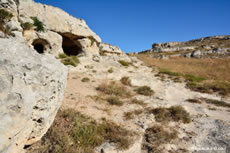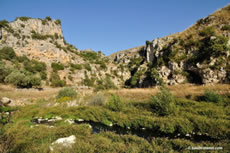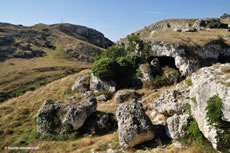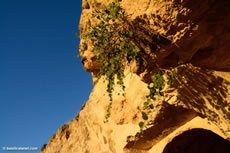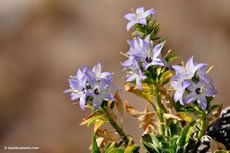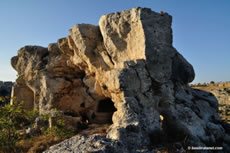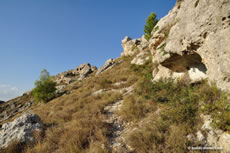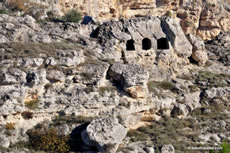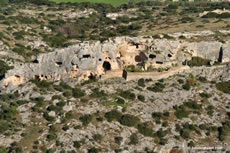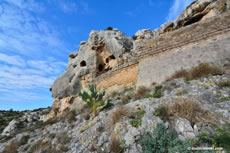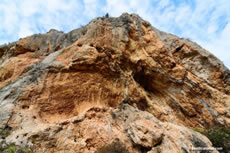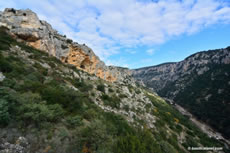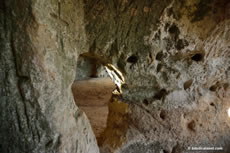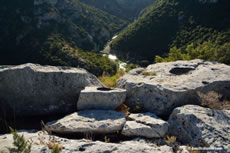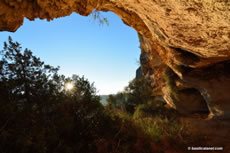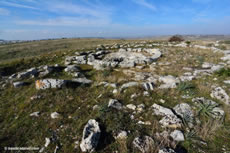
The Murgia Park
The Parco Archeologico Storico Naturale delle Chiese Rupestri del Materano (Natural Historical Archaeological Park of the Rock Churches of Matera), more simply known as the Parco della Murgia Materana (Murgia Park), is located in the eastern part of Basilicata on the border with Puglia and covers an area of about 8,000 hectares in the territory of Matera and Montescaglioso. The park area is included in the UNESCO World Heritage list together with the Sassi di Matera.
Park Territory
The area was frequented since prehistoric times, as evidenced by the numerous fossil finds on display at the Domenico Ridola National Archaeological Museum in Matera, the stationing of the Bat Cave, frequented in the Paleolithic period, and the Neolithic villages of Murgia Timone, Murgecchia and Trasanello surrounded by defensive ditches dug into the rock, which are characterized in the Middle Neolithic by Serra d’Alto pottery, a brown-painted figulina pottery with geometric motifs and ribbon-like handles with often animal protomes that takes its name from the hill of the same name in the Matera area, and which is associated in the late Neolithic with Diana Bellavista pottery, a red-colored pottery with different shades and elongated spool handles that takes its name from the Diana settlement of Lipari and the Masseria Bellavista necropolis in Taranto.Over the centuries the territory has been inhabited by shepherds and herdsmen who have left numerous testimonies of their dwelling in fact, numerous are the farmhouses, rock villages including San Nicola all’Ofra, Cristo la Selva, the Saracen Village all equipped with rock church and burial area. Many of these structures are complemented with iazzi, rock addiacci carved out of caves with dry stone walls that enclose the outdoor space to house cattle and sheep, always made on a slope to evacuate sewage to the manure farm and facing south to protect the animals from the cold northern winds. Other forms of shelter for animals are the rupestrian caprili, complexes of caves dug along ravines in inaccessible places but particularly suitable for housing goat breeds.
There are also numerous systems of canalization that take advantage of networks of surface canals to convey rainwater into wells and condensation cisterns, used to water the herds during transhumance. Another constant presence in the Murgia area is that of the masserie, many of them fortified, which at certain times of the year became veritable villages, where fixed wage earners were joined by seasonal ones. They are characterized by the presence of a central courtyard, the baronial building, the lodgings of the wage earners and storage rooms for grain and work tools. Other typical elements include towers, sentry boxes, and boundary walls ending in patrol walkways.
Rupestrian Churches
One of the most important features of the Murgia is the presence of more than a hundred rock-hewn churches scattered throughout the territory, sometimes hidden by dense vegetation and excavated along the steep banks of the ravines in inaccessible and difficult-to-access places, embellished with spectacular frescoes that testify to the devotion that has continued to the present day. The churches that are partly excavated and partly built have a single nave, such as the one known by the name of "Crypt of the Scaletta" and the one of the "Madonna of the Cross," two naves such as the church of the "Old Capuchin" or the one known as the "Crypt of the Canary" or three naves such as the "Madonna of the Three Doors" or "St. Peter on the Appian Way."The churches, especially those built in the Romanesque period, have the architectural and decorative elements typical of sub divo churches of the period such as apses, four-lobed columns, walls that take on the functions of transepts, walls decorated with blind arches and projecting capitals, vaults embellished with small domes with concentric circles, humpbacked ceilings, and cornices decorated with broken lines. Some rock churches are linked to the presence of Benedictine monks, such as the "Cave of the Saints," called today by the name "Crypt of Original Sin," certainly among the oldest in the region, on whose walls a pictorial cycle dating back to the 9th century is frescoed.
Sanctuaries
There are numerous shrines dedicated to the Virgin Mary such as St. Mary of the Palomba, Our Lady of the Cross, Our Lady of the Virgins, St. Mary of the Green Valley, Our Lady of the Murgia, and to the Holy Crucifix that of Christ at Gravinella, Christ the Forest and Christ at Guirro. Other churches are dedicated to Archangel Michael such as, to name but a few, S. Angelo della Mensa, S. Angelo lo cupo and the crypt of Cozzo S. Angelo. A recurring theme on the walls of the churches is the fresco of St. Vitus, protector of the peasants, and that of St. Nicholas protector of all the shepherds of the Murgia, testifying to the inseparable relationship that binds the peasant, the shepherd and the inhabitant of the Murgia in general to religion.Flora and fauna of the park
The Park preserves a considerable variety of plants typical of the Mediterranean forest such as the downy oak, the strawberry tree, the carob tree, the holm oak, of the Mediterranean scrub such as the juniper, the mastic tree, the broom, and of the garrigue such as the cistus, the butcher’s broom, the thorny thyme, the ferula, and the asphodel.There are numerous varieties of flowers such as meadow vedovella, Pugliese bellflower, Ionic helicanthus, elegant convolvulus, tommasini flax, thomas saffron, and ofris matheolana a small and rare endemic orchid.
The fauna is also significant; among the trails it is possible to encounter porcupines, martens, foxes, weasels, badgers, wild cats and wild boars. Birds of prey include the Egyptian vulture, buzzard, red kite and the Lesser Kite, a small hawk adopted as the symbol of the park, which arrives in the spring from the African savannas, breeds and in the fall heads southwest to the Sahara Desert to winter.
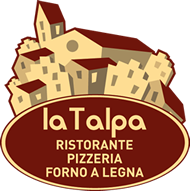

 Home
Home
